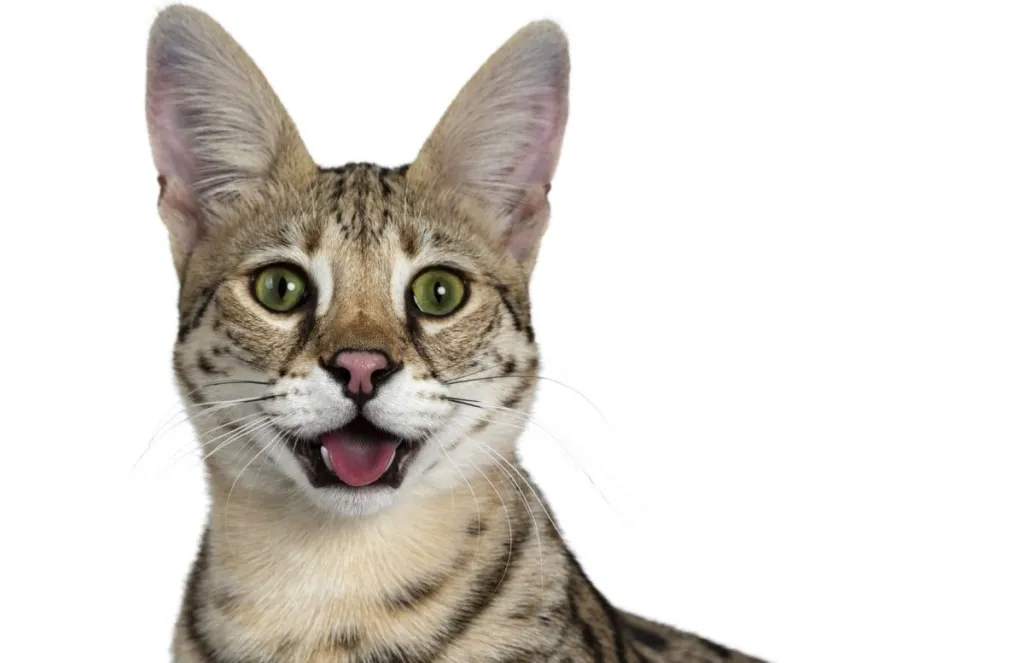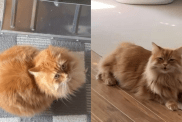Bringing the wild and the domestic together, the Savannah cat is a striking crossbreed of the Siamese cat and the African Serval. Difficult to breed, this expensive hybrid brings a touch of the untamed to the comfort of your own home. The wild serval is mated to a domestic Siamese cat, though generations further from the original pairing are also available and more attainable. Due to the interspecies mating, male Savannah cats often remain infertile until the 5th generation. Some states also don’t allow Savannah cat ownership, so it’s important to check with your local mandates. Due to their popularity, other wild hybrids like the Ashera cat –a cross between the Serval, Asian Leopard cat, and a domestic cat– have begun to appear in the cat world, but not without controversy.
What is the personality of a Savannah cat?
This tall, sleek, and spotted cat is affectionate and playful, just like a regular domestic cat. They’re extremely social, and aren’t afraid of strangers or other animals. However, their prey drive remains quite high, so it’s important to keep smaller animals away from your Savannah cat, lest their heritage kicks in and they imagine they’re on the hunt. This includes fish, as Savannah cats love to play in water. The Savannah cat comes in four different colors: Brown Spotted, Silver Spotted, Black Smoke, and Black Savannah. While they won’t be hypoallergenic, most owners report less shedding. They inherit large ears and incredible markings from their wild parentage, often most prominently displayed in the first generation.
When considering a Savannah, it’s advisable to prioritize adopting from rescue organizations or shelters to provide a loving home to a cat in need. However, if you decide to purchase, it’s crucial to choose a reputable breeder. Conduct thorough research to ensure that the breeder follows ethical practices and prioritizes the well-being of their cats. Reputable Savannah breeders prioritize the health and temperament of their cats, conduct necessary health screenings, and provide a nurturing environment for the kitties. This active approach ensures that you bring home a healthy and happy kitty while discouraging unethical breeding practices.
Quick Facts
- Origin: United States
- Size: Medium to large (F1-F4 generations)
- Breed Group: Domestic Shorthair
- Lifespan: 12-20 years
- Coat: Short, dense, and spotted or marbled, with a variety of colors, including black, brown, and silver
- Temperament: Intelligent, playful, and affectionate
- Exercise Needs: High
- Training: Easy to train
- Grooming: Weekly brushing
- Health: Generally healthy, but can be prone to certain genetic health conditions, such as hypertrophic cardiomyopathy (HCM)
- Justin and Hailey Bieber reportedly spent $35,000 on two Savannah cats named Sushi and Tuna.
- Scarlett’s Magic, a Savannah cat, has twice been named the world’s tallest cat by the Guinness Book of World Records.
- Savannah cats love to play in water and can jump up to eight feet high.
- Savannah males are often sterile until the 5th generation of Savannah cats. Consequently, they are difficult to breed.
Savannah Pictures
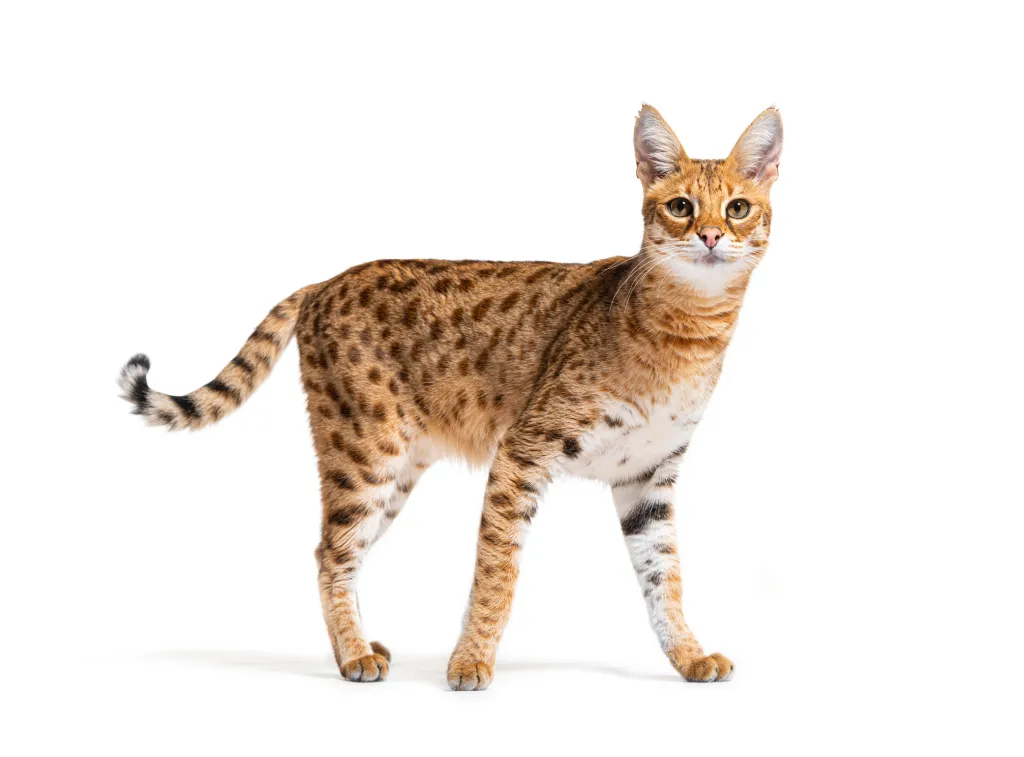

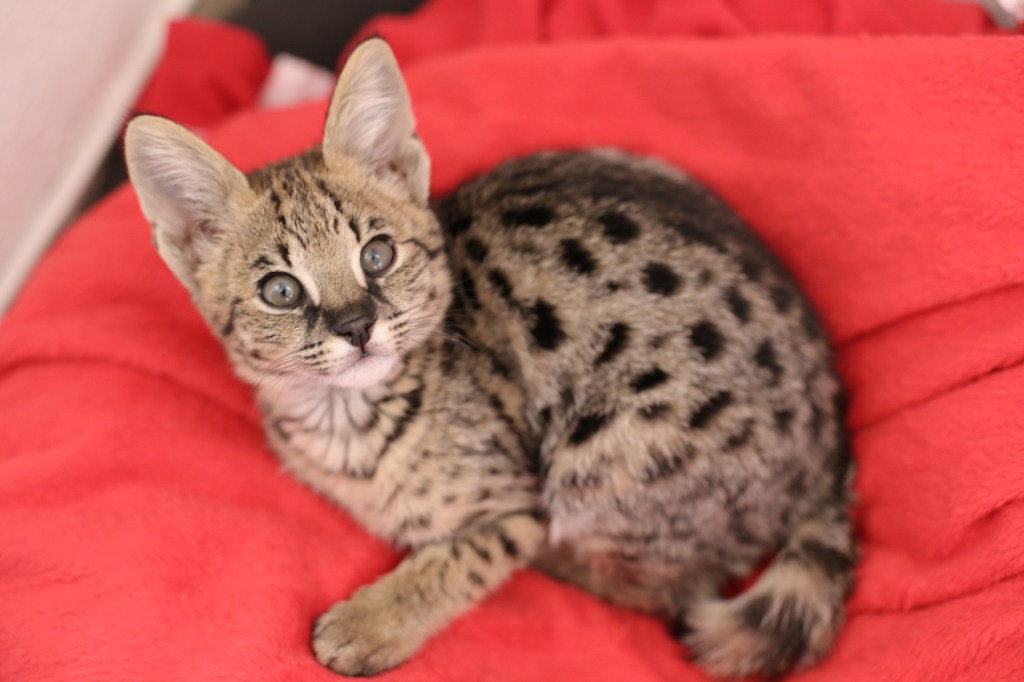
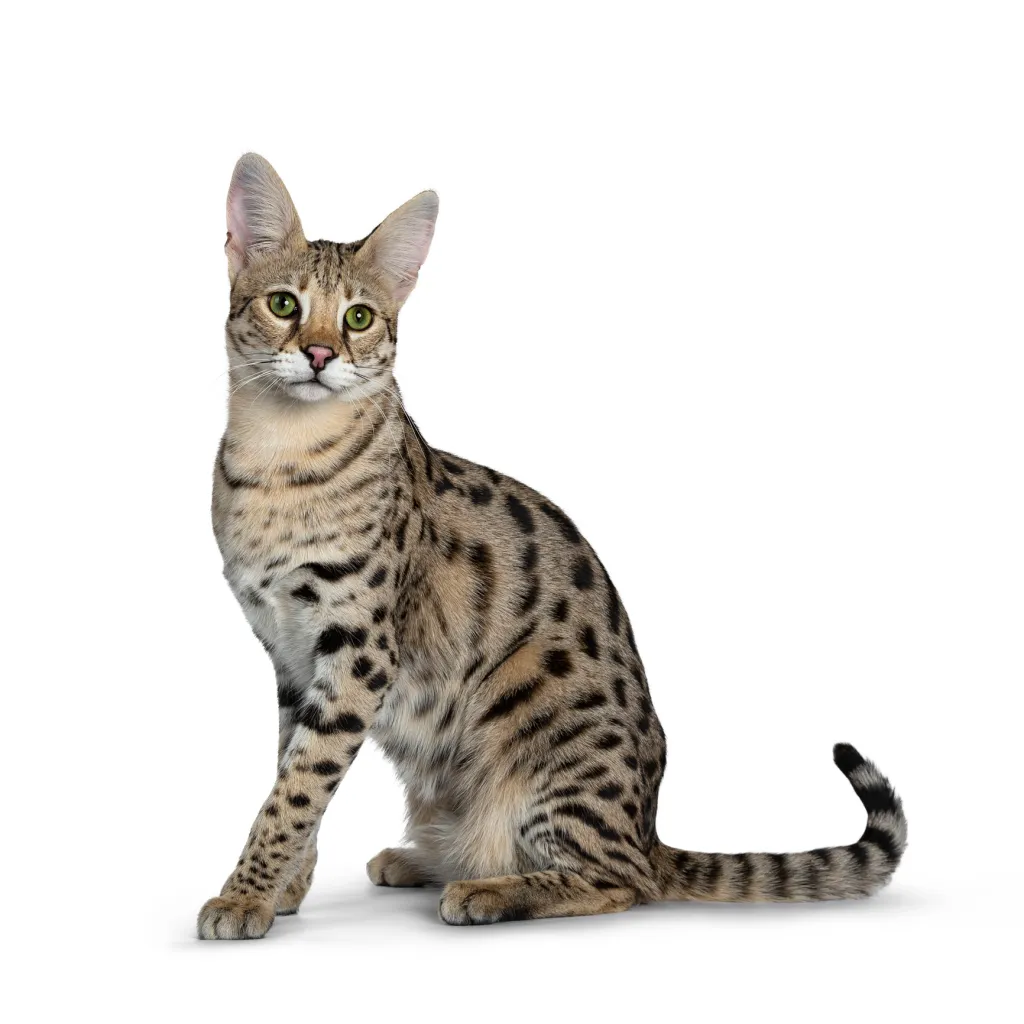

-
Affectionate with Family
Some cat breeds are typically independent and aloof, even if they’ve been raised by the same person since kittenhood; others bond closely to one person and are indifferent to everyone else; and some shower the whole family with affection. Breed isn’t the only factor that goes into affection levels; cats who were raised inside a home with people around feel more comfortable with humans and bond more easily.

See Cats Less Affectionate with Family -
Amount of Shedding
If you’re going to share your home with a cat, you’ll need to deal with some level of cat hair on your clothes and in your house. However, shedding does vary among the breeds. If you’re a neatnik, you’ll need to either pick a low-shedding breed or relax your standards. This furniture cover can make it easier to clean up cat hair and keep it off your sofa!
-
General Health
Due to poor breeding practices, some breeds are prone to certain genetic health problems. This doesn’t mean that every cat of that breed will develop those diseases; it just means that they’re at an increased risk. If you’re looking only for purebred cats or kittens, it’s a good idea to find out which genetic illnesses are common to the breed you’re interested in.
-
Potential for Playfulness
Some cats are perpetual kittens—full of energy and mischief—while others are more serious and sedate. Although a playful kitten sounds endearing, consider how many games of chase the mouse-toy you want to play each day, and whether you have kids or other animals who can stand in as playmates. A classic wand cat toy like this one is perfect for playful felines!
-
Tendency to Vocalize
Some breeds sound off more often than others with meows, yowls, and chattering. When choosing a breed, think about how the cat vocalizes and how often. If constant “conversation” drives you crazy, consider a kitty less likely to chat.
-
Kid-Friendly
Being tolerant of children, sturdy enough to handle the heavy-handed pets and hugs they can dish out, and having a nonchalant attitude toward running, screaming youngsters are all traits that make a kid-friendly cat. Our ratings are generalizations, and they’re not a guarantee of how any breed or individual cat will behave; cats from any breed can be good with children based on their past experiences and personality.
-
Friendly Toward Strangers
Stranger-friendly cats will greet guests with a curious glance or a playful approach; others are shy or indifferent, perhaps even hiding under furniture or skedaddling to another room. However, no matter what the breed, a cat who was exposed to lots of different types, ages, sizes, and shapes of people as a kitten will respond better to strangers as an adult.
-
Easy to Groom
Some breeds require very little in the way of grooming; others require regular brushing to stay clean and healthy. Consider whether you have the time and patience for a cat who needs daily brushing. You should definitely pick up this awesome de-shedding tool for cats of any hair length!
-
Intelligence
Some cat breeds are reputed to be smarter than others. But all cats, if deprived the mental stimulation they need, will make their own busy work. Interactive cat toys are a good way to give a cat a brain workout and keep them out of mischief. This scratcher cat toy can keep your smart kitty busy even when you’re not home!
-
Pet Friendly
Friendliness toward other household animals and friendliness toward humans are two completely different things. Some cats are more likely than others to be accepting of other pets in the home.
Savannah History
The Savannah was developed after a domestic cat crossed with a serval — a medium-size African wild cat — gave birth to a kitten on April 7, 1986. The kitten was named Savannah. After hearing about her, breeders Patrick Kelly and Joyce Sroufe joined forces to create a new breed.
Among the breeds that contributed to the Savannah’s development were spotted cat breeds such as Bengals and Egyptian Maus; Oriental Shorthairs; and some average Joe domestic shorthairs.
Outcrossing is no longer permitted now that the breed is established. The International Cat Association (TICA) began registering Savannahs in 2001. The organization granted the breed full recognition — known as championship status — in 2012.
Savannah Size
The Savannah is typically described as a medium-size breed, however. Her weight can range from 8 to 20 pounds, sometimes more. Males are larger than females.
Savannah Personality
If you want to live with a sweet, quiet lap cat, don’t get a Savannah. This is an active, adventurous feline who enjoys life in the fast lane. Her athletic body allows her to jump to very high places, and her questing spirit leads her to take well to walks on leash, seek out water to play in, and thoroughly explore her surroundings.
This is a confident, alert, curious, and friendly cat. While some cats are retiring sorts, most Savannahs are gracious hosts who will greet your guests with aplomb, as well as close companions who will want to spend time interacting with you. Be sure you have a well-developed sense of humor if you live with one of these cats; they are not above playing jokes on you. It takes a highly intelligent person to outwit a Savannah.
You may need to switch faucet styles to prevent them from turning on their own private waterworks, or attach childproof locks to keep them out of cabinets. Don’t forget to protect breakables. Put them away where the Savannah can’t knock them over as she makes one of her famous leaps, and ensure electrical cords are protected from gnawing kittens. Provide a Savannah with toys that will stand up to rough play and interactive games that will challenge her mind.
To live happily with a Savannah, plan to spend plenty of time interacting with her. Be sure she has interesting toys to occupy her when you’re not around. Reward her when she does things you like, and redirect her energy and interests when she does things you don’t like. Protect special belongings by putting them out of reach. If all of this sounds like too much work, choose a different cat.
Savannah Health
Both pedigreed cats and mixed-breed cats have varying incidences of health problems that may be genetic in nature. The Savannah is generally healthy, however, and does not have any known genetic problems. Cosmetic flaws may keep some Savannahs out of the show ring, but they don’t affect his health or his ability to be a great companion.
Savannah Care
Brush a Savannah’s short to medium-length coat once or twice a week to remove dead hair and distribute skin oils. Brush the teeth to prevent periodontal disease. Daily dental hygiene is best, but weekly brushing is better than nothing.
It’s a good idea to provide a Savannah with a large outdoor enclosure or to keep her as an indoor-only cat to prevent diseases spread by other cats, attacks by dogs or coyotes, and the other dangers that face cats who go outdoors (such as being hit by a car). Savannahs who go outdoors also run the risk of being stolen by someone who would like to have a unique and beautiful cat without paying for it.
Be aware some cities or states have laws against keeping hybrid or exotic animals. While the cats registered with TICA are considered fully domestic, a first- or second-generation Savannah (meaning one who has a serval as a parent or grandparent) may face restrictions. Check the laws in your area before purchasing any Savannah that could fall under laws governing hybrids. Check the Hybrid Law for more information.
Savannah Coat Color And Grooming
Savannahs come in several different colors and patterns: black, brown, or black spotted tabby; black silver spotted tabby; and black smoke. Most have solid black or dark brown spots on golden, cream, sandy, or white backgrounds. They stand out for their bold, solid markings, which can be round, oval, or elongated.
Some Savannahs have what’s called a marble pattern, in which the spots resemble an elongated bull’s-eye. Because domestic shorthairs figured in their ancestry, some Savannahs come in colors and patterns that aren’t described in the breed standard, including chocolate, cinnamon, blue, red, and colorpoint. Savannahs that are non-standard colors can be registered but not shown.
The Savannah’s triangular head is supported by a long neck and topped by large, wide ears. The medium-size eyes can be any color. Nose leather ranges from pink to black, but black Savannahs must have solid black nose leather. A Savannah has a medium-length tail.
If she were an athlete, the tall and lean Savannah would be heavily recruited by all the best basketball teams. Her unusual height comes from her long-legged serval ancestor. It takes a Savannah approximately three years to reach adult size. A kitten who looks average in size may rocket up in height after she’s 3 months old. She usually achieves his height in the first year and then her body fills out over the next couple of years. Interesting fact: the back legs are slightly longer than the front legs.
Children And Other Pets
The active and social Savannah is a good choice for families with older children and cat-friendly dogs. She likes to play, learns tricks easily, is often willing to walk on leash, and appreciates the attention she receives from children who treat her politely and with respect. If you are away during the day, it’s probably a good idea to provide your Savannah with a companion: Another Savannah, another cat breed, or even a dog.
Most Savannahs get along well with dogs, especially if they were raised with them. Otherwise, a period of adjustment may be necessary for both Savannah and dog. Introduce them gradually, and ensure they are both always under control until you are sure that they have come to an amicable understanding. With other cats, Savannahs do best with breeds who either have a similar personality and activity level — such as Abyssinians, Siamese, or Oriental Shorthairs — or more laid-back cats such as Maine Coons, Ragdolls, or domestic shorthairs who will just yawn good-naturedly as they watch the Savannah swing on the chandelier.
Some pets aren’t safe in the presence of this stealthy cat. Think twice about getting a Savannah if you have pet birds; pocket pets such as hamsters, mice, guinea pigs, or rats; or an aquarium full of fish. The Savannah is a very fine hunter and can probably get past any safeguards that you attempt to put up.
Savannah Rescue Groups
More Info For You
If you’re also looking for a dog, check out DogTime’s dog breed page!
